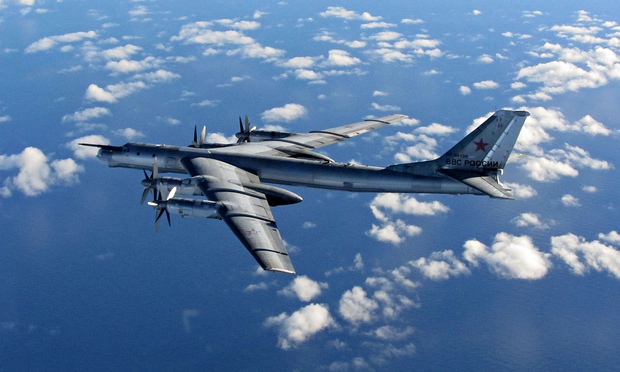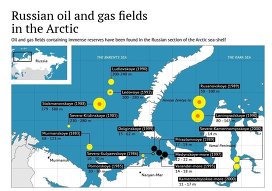Nuclear-capable Russian bombers are flying over the North Sea and the Atlantic. And U.S. Air Force officers are very concerned at what could be a rehearsal of a deadly mission.
Russian bombers may be flying nuclear strike drills over the Atlantic Ocean and North Sea, current and former U.S. Air Force officers believe. At the very least, these officers tell The Daily Beast, the Russian Air Force is aggressively probing what NATO calls European airspace in an effort to gauge the reaction times of the western alliance’s defenses.
Since Oct. 28, NATO air defenses have detected and monitored four groups of Russian combat aircraft over the Baltic Sea, North Sea, Atlantic Ocean, and Black Sea. Norwegian F-16 fighters intercepted one particular group of Russian aircraft on Oct. 29 that included four, nuclear-capable Tupolev Tu-95 Bear H strategic bombers and four Ilyushin Il-78 aerial refueling tankers. Once intercepted, six of the Russian aircraft headed for home while the two remaining Tu-95 bombers continued southwest, parallel to the Norwegian coast, before eventually turning back towards Russia.
The giant, propeller-driven Tu-95 is a launch platform for the 1,600 nautical mile range Raduga Kh-55 nuclear-tipped cruise missile. The weapon carries a 200-kiloton nuclear warhead; by comparison, the bomb that destroyed Nagasaki was a mere 21 kilotons. Some active-duty and retired U.S. Air Force officials told The Daily Beast that the Tu-95s might have been flying to certain predetermined launch points for their nuclear missiles.
“That could certainly be the case,” said retired Air Force Lt. Gen. David Deptula, the service’s influential former intelligence chief. “It is not farfetched that at some point within the next two years [Russian President Vladimir] Putin makes a more aggressive move in Eastern Europe and uses a nuclear threat to deter a NATO response.”
Of course, every nuclear capable air force runs exercises to practice its so-called “strategic deterrence.” It’s the pace and scale of these current flights that have military observers concerned.
“Our bomber crews regularly fly training sorties for their full range of potential missions, including strategic deterrence practice missions,” Mark Gunzinger, a former B-52 pilot and current air power analyst the Center for Strategic and Budgetary Assessments, said. “[The Russian Air Force] has never stopped flying training sorties, but it’s apparent that the scope of this one is catching people’s attention.”
Asked if at least some of these flights were nuclear drills, Gunzinger responded, “that is probably the case.”
The giant, propeller-driven Tu-95 is a launch platform for the Raduga Kh-55 nuclear-tipped cruise missile, which carries a 200-kiloton nuclear warhead. By comparison, the bomb that destroyed Nagasaki was a mere 21 kilotons.
Another former Air Force officer—one with extensive experience with Russian tactics—cautioned not to interpret either the European or Alaskan flights too darkly. “A probe to test western responses, yes,” the former officer wrote in an email. “More activity than in the recent past, yes. Nuclear strike rehearsal, unlikely. Capabilities are easy to measure. Intent is not.”
Analyst Rebecca Grant, president of IRIS Independent Research, said that the recent display of Russian air power was just another provocation in a long line of similar antagonistic moves by Russia. The Russian strategic bomber foray into the Atlantic is also reminiscent of a September incident where two nuclear-capable Tu-95s bombers, two Il-78 tankers and two MiG-31 Foxhound fighters were intercepted near Alaska.
“This reminds me of the exercises Russia has been flying in the Pacific for a few years now, just transferred to the European theater,” Grant said. “I don’t read this as a specific nuclear or conventional scenario practice, rather an exercise in long-range navigation and provocation. It’s clearly designed to annoy NATO but from a purely tactical perspective, this was still a pretty small display of airpower.”
Another former Air Force F-4G and F-15E electronic warfare officer said that there simply is not enough information to be certain of what the Russians’ intentions are. “It could be anything,” said Michael Pietrucha. “There’s nothing wrong with long range training sorties because they allow you to work out the kinks for a variety of missions.”
Nonetheless, the foray into European airspace by the Tu-95 Bear bombers is cause for concern. That’s not just because of the Bear bomber’s long-range nuclear weapons capability, but also because of the Russian’s general disregard for international air traffic norms. Not only did the Russians not file a proper flight plan, they also did not have active transponders—which would allow civilian air traffic controllers to see them. The situation could lead to a serious accident where an airliner might collide with a Russian bomber.
“It’s alarming, especially, that they would fly without their transponder on particularly when they’re certain to fly on or cross an a multitude of international air routes,” one Air Force bomber pilot told the Daily Beast. “The interrogative capability of most modern airline and transport carrier transponders rely on the transmission of other transponders to ensure positive deconfliction.”
The airspace over the Atlantic is especially busy with a lot of airliner traffic. The U.S. bomber pilot acknowledged that the U.S. Air Force also conducts long-range bomber patrols, but American aircraft always follow proper flight procedures and other regulations.
“I’ve flown on the west of Portugal, it was a busy place to fly because a lot of air routes funnel into the Med [Mediterranean] there,” the bomber pilot said. “The U.S. does what are called ‘global power’ missions on occasion, but never without squawking, or talking, or filing flight plans, and we rarely seek to draw an escort.”
In addition to the strategic bomber patrols in the Atlantic, the Russian Air Force also flew another bomber mission over the Black Sea on Oct. 29 with two Tu-95 Bears, which were escorted by two Sukhoi Su-27 air superiority fighters.
The Russian Air Force also flew additional sorties over the Baltic Sea with tactical strike fighters on Oct. 29. Portuguese F-16 fighters assigned to protect the Baltic states—which belong to NATO—intercepted a group of two MiG-31 interceptors, one Su-27 fighter and two pairs of Su-34 and Su-24 fighter bombers. The same group of Russian jets was intercepted on the previous day.
No matter what the intent of the specific flight, the larger goal—a re-introduction of Russian military might into Europe—is clearly working, a senior U.S. military officer told The Daily Beast.
“It certainly demonstrates their effort to re-assert themselves in the region and regain their past form,” this official added. “It appears to be successful, certainly from the standpoint that Russian airpower has re-entered the conversation and our NATO allies have had to respond to their incursions. It strikes me as destabilizing.”
The U.S. Air Force would not officially comment on the matter and deferred all queries to the Office of the Secretary of Defense. The Pentagon did not return calls for comment.
Credit to The Daily Beast









